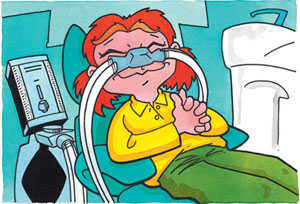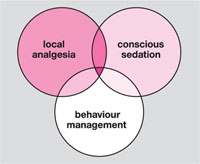Chapter 10
Conscious Sedation 4: What to Use and How to Use It
Aim
The main aim of this chapter is to review sedative drugs and techniques that can be used by general dental practitioners. Particular emphasis will be placed on nitrous oxide inhalation sedation since this is the most common technique used for paediatric dental sedation. A secondary aim is to give dentists an overview of the benzodiazepine, midazolam, since this is becoming increasingly used in specialist referral centres.
Outcome
The dental sedationist and their team should:
-
become familiar with inhalational, oral and intravenous routes of administration and be aware of the relative pros and cons of each
-
know the indications and contraindications for nitrous oxide inhalation sedation
-
understand how to develop their own nitrous oxide inhalation sedation technique
-
gain an insight into the use of midazolam.
Introduction
Conscious sedation helps to reduce fear and anxiety and enables the anxious but potentially cooperative child not only to accept dental treatment but also to cope better with dental care in future (Fig 10-1). Although broad aspects of dental sedation will be touched upon, this text is intended to assist colleagues working in primary dental care within the United Kingdom and will therefore concentrate on those sedative agents and techniques that are the most likely to be safely and successfully used for child patients within that sector.

Fig 10-1 Sedated child.
Routes of Administering Sedative Drugs to Children
The following routes are used most commonly to administer drugs that produce sedation in dental practice:
-
inhalational
-
oral
-
rectal
-
intramuscular
-
intravenous.
Inhalational
Nitrous oxide gas has been used extensively in dental practice and is well noted for its analgesic and anaesthetic properties.
Nitrous oxide
-
Is a very weak analgesic and so requires concomitant local anaesthetic agents.
-
Involves the use of low concentrations of nitrous oxide gas in combination with oxygen for inhalational sedation in conscious patients.
-
The technique incorporates behavioural management and hypnotic suggestion.
-
Was described as early as 1889 when it was used during cavity preparation in Liverpool Dental School.
-
Has been described in detail in the dental literature.
Oral
A survey of current premedication trends in paediatric dental practice in the USA found the oral route to be the most popular in paediatric dentistry. Advantages of this route are:
-
ease of administration
-
decreased incidence of allergic reaction.
However, major disadvantages include:
-
prolonged onset and duration of action
-
unpredictable gastric absorption
-
dependence on the compliance of the patient
-
difficulty in determining appropriate dosages.
Rectal
Although the rectal route has been reported to be successful in paediatric dentistry literature, especially in Scandanavia, it has not found widespread acceptance in the United Kingdom. This is probably because an enema is required, a procedure best performed in hospital rather than a dental practice.
Intramuscular
The intramuscular technique has several advantages over the oral route in that it allows:
-
a more rapid onset of effect
-
more reliable absorption of the agent into the circulation.
However:
-
it is difficult to titrate medications with sufficient accuracy to obtain a predictable response
-
an intramuscular injection is needed! This can be distressing for an already anxious child
-
many dental practitioners are not familiar with intramuscular injection techniques.
Intravenous
The intravenous route of drug administration is the most effective method of ensuring predictable and adequate sedation of rapid onset and short duration in adults.
However:
-
this requires venepuncture!
-
children have such small veins and chubby hands
-
it is generally reserved for anxious adolescents who are mature enough to accept it and adult dental patients
-
this is the least well researched route in paediatric dental sedation and so is not generally recommended for use in primary dental care settings.
Drugs Used to Sedate Children for Dentistry
The commonest drugs used when anxious children are undergoing dental treatment under conscious sedation are local anaesthesia and nitrous oxide.
Nitrous oxide inhalation sedation
Properties of nitrous oxide
Nitrous oxide has only a mild sedative effect so inhalation sedation is more reliant on operator suggestion than other sedative techniques. The operator’s ability to relax and talk the patient through the process is as critical as the drug itself. In this sense inhalation sedation augments other behavioural management techniques it does not replace them (Fig 10-2).

Fig 10-2 The association between local anaesthesia, conscious sedation and behavioural management.
Nitrous oxide gas:
-
has a sweet odour that is pleasant to inhale
-
is non-irritant to both the lungs and nasal passages.
Poor tissue solubility ensures the effects are of rapid onset and that recovery is fast. Remember, children can become hypoxic much more readily than adults and so if too little oxygen is delivered they can be rendered unconscious.
How well does nitrous oxide inhalation sedation work?
In the last fifteen years there hav/>
Stay updated, free dental videos. Join our Telegram channel

VIDEdental - Online dental courses


